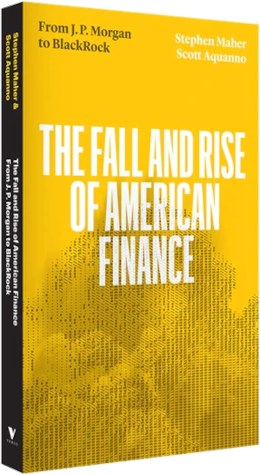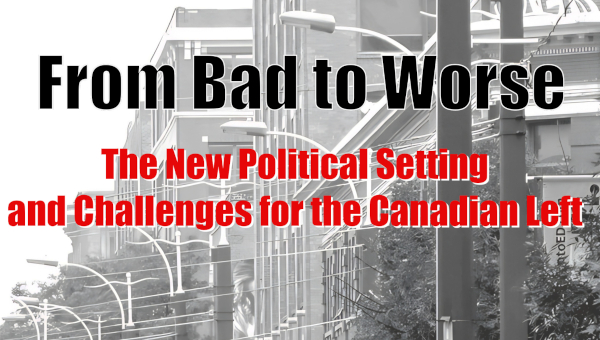The Power of Finance Is Inherent to Capitalism
This is an extract from The Fall and Rise of American Finance: From JPMorgan to BlackRock by Scott Aquanno and Stephen Maher, available now from Verso Books.
Scott Aquanno and Stephen Maher were in Toronto on April 27th for a book launch, watch video.
Much of the Left sees finance as being parasitic on industry. Financialization, in this view, amounts to financial institutions capturing the state, hollowing out the “real” economy, and hastening the decline of capitalism.
But if we survey the last century of capitalist development, we find that, despite the costs to workers and the middle class, financialization has actually boosted competitiveness and strengthened capital – all with the support of an ever stronger and more authoritarian state.
This has culminated since the 2008 crisis in a new economic regime marked by unprecedented concentration and centralization in the hands of the “Big Three” asset management firms (BlackRock, Vanguard, State Street) and supported by the extensive “statization” of the financial system.
Understanding how finance has strengthened, not harmed, capital has enormous political implications. First, it challenges the idea that the working class should form an alliance with industrial capital against a “parasitic” financial sector that exploits them both. Similarly, it shows the naivety of suggestions that workers could form an alliance with the asset management firms around the environment or social spending.

Finally, it undermines the notion that the problem with contemporary capitalism is the need to “restore competitiveness.” The system isn’t broken and in need of fixing. It is functioning properly and needs to be gotten rid of.
The New Finance Capital
The history of financialization has four distinct phases: classical finance capital, managerialism, neoliberalism, and new finance capital. These phases form a cycle consisting of the decline and then the gradual, uneven, and contradictory rebuilding of financial power. Each phase is characterized by specific organized forms of state, corporate, and class power, with transitions marked not by sharp “breaks” but rather by both continuity and change.
The new finance capital was formed after the 2008 crisis, as the diffuse financial power of neoliberal shareholder capitalism was centralized in giant asset management companies. Amid the financial meltdown, regulators sought to enhance systemic stability by orchestrating bank consolidation. When the dust settled, just four megabanks – JPMorgan Chase, Bank of America, Wells Fargo, and Citigroup – dominated the sector.
Ironically, however, state intervention contributed to a move away from banks and toward a group of asset management companies: BlackRock, State Street, and Vanguard. As the formation of the risk state dramatically reduced the riskiness of stocks, asset management firms facilitated a flood of money into these assets. Channeling savings into stocks further reduced their riskiness and led to continuous stock price increases – as well as equally continuous concentration and centralization of ownership by asset managers.
An important foundation of the concentrated ownership of asset management companies are the pension funds and other institutional investors, which increasingly delegated management of their portfolios to these firms. By pooling the already massive pools of capital accumulated in these funds, asset management companies further centralized financial power, gaining a degree of economic dominance unseen since the days of JPMorgan.
This was underpinned by a historic shift toward passive management. Unlike active management, whereby highly paid money managers seek to maximize returns by “beating the market,” passive funds hold shares indefinitely, trading only to track movement in a particular index – allowing them to offer dramatically lower management fees and, especially in the context of rising share prices, high returns.
But these passive investors are active owners. Since they cannot discipline industrial corporations by simply trading shares, they have pursued more direct methods of influence.
If the rise of the asset management firms was part of a historic shift in the organization of American capitalism, this revolved in particular around the preeminence of BlackRock. By 2022, BlackRock’s assets under management had reached $10-trillion. If one includes the assets it indirectly manages through its Aladdin software platform, this number approaches $25-trillion. BlackRock is now among the major owners of nearly every major publicly traded US company.
Never before has the concentration of capital reached such a staggering extent. Its power is reflected not only in the size of its assets under management, but also in its special connection to the state. Whereas George W. Bush chose Hank Paulson of Goldman Sachs to be Treasury secretary during his administration, Hillary Clinton and Joe Biden both considered BlackRock CEO Larry Fink for that post. Biden’s top economic advisor, Brian Deese, is also a BlackRock executive.
Rethinking Finance
Financialization is rooted in the evolution of capitalism as it works out its tensions and antagonisms. Since the contradictions of capitalism can never be fully resolved, it must change continuously to overcome the barriers and crises they generate – a process akin to Darwinian adaptation. Class conflict is the most important, but by no means the only such contradiction.
While the stock market crash of 1929 was certainly followed by waves of working-class struggle in the 1930s, it also revealed the profound instabilities of the bank-centered system of finance capital. This spurred the state to separate banks from corporate governance, in turn leading the industrial corporation to take on new financial functions. Subsequently, these firms adapted to the challenges of managing increasingly complex, internationalized, and diversified operations by reorganizing corporate planning as an internal financial market.
When working-class militancy squeezed corporate profits in the 1970s, financialization and globalization imposed class discipline and reduced labour costs, thus restoring profits and allowing accumulation to resume. The regime of financial hegemony that emerged from this was centered around banks, as well as a new group of institutional investors who held large concentrations of stock. These institutions were linked with a new system of market-based finance, which depended on a complicated chain of financial exchanges to generate credit.
The collapse of this system was at the core of the financial crisis of 2008 – the deepest crisis of capitalism since the 1930s. Subsequently, through a range of drastic and unprecedented interventions, the state restructured the financial order. By providing extensive liquidity to stabilize the system, the state inadvertently facilitated the consolidation of a new form of finance capital centered around asset management firms.
Finance and industry are not antagonistic, but fundamentally interlinked. Finance was not a problem but a solution for the systemic contradictions of capitalism. This picture of how finance has been functional to capitalist development differs sharply from the many accounts that see its ascent as a sign of decay that emerged only at a relatively recent “late” stage.
1) Financialization Is Not New
As Rudolf Hilferding already understood at the dawn of the twentieth century, forms of financialization have been present from the earliest days of corporate capitalism. For him, the key feature of the corporation was that it allowed industry to be “operated with money capital.” The joint-stock company replaced the personal ownership of industrial assets with impersonal ownership of tradable shares – monetary instruments that also afford control over industrial firms.
Control over production came to be reorganized around possession of money-capital, rather than direct ownership of fixed capital such as machinery and factories. Consequently, during the classical finance capital period, the banks’ possession of concentrated pools of money and capacity to generate credit allowed them to play the most active part in forming and controlling corporations.
After the demise of the investment banks, a new form of corporate financialization emerged during the managerial period – often held up as the pinnacle of “pre-financialized” capitalism. During the postwar decades, industrial corporations increasingly became financial institutions. Very high profits and relatively weak investors left industrial managers in control of large pools of retained earnings, which they lent out on financial markets, entering into direct competition with banks.
Meanwhile, these firms adapted to the challenges of internationalization, diversification, and the growing scale of production through the development of internal capital markets – in which top executives allocated money-capital across what they increasingly saw as a portfolio of competing financial assets. This process was already well underway by the time investor power reemerged in the 1980s, which has today taken the form of the concentrated ownership by asset managers.
2) Finance and Industry Are Not Separate
Control over capital is inherently financial: it depends on the ability to access money in a sufficient quantity to be set in motion so as to generate profit. The economic power of capital results above all from the ability to direct investment, which determines the use to which society’s productive capacities are put. All capitalists are, in a sense, financiers, faced with the choice of investing in one thing or another and pursuing the most profitable opportunities.
Nevertheless, capital is divided into fractions: finance plays a specific role in the overall structure of accumulation, competitively circulating investment across the various branches of production. Finance depends on industrial profits to receive interest, while industry engages with the financial system to raise investment and circulate capital. Even when not fused into finance capital, therefore, finance and industry are deeply interdependent.
Political strategies that aim to isolate finance as the cause of “bad” capitalism, as opposed to “good” manufacturing, are thus bound to fall short. For one thing, capitalists instinctively understand attacks on finance as challenges to capital as a whole. More fundamentally, this framing fails to appreciate the extent to which, in a very material way, the interests of finance and industry have become almost indistinguishable.
It is not possible to separate a discrete group of industrialists who have been victimized by financialization from financiers who have benefitted from it. While the internal restructuring of the firm converted industrial managers into financiers, globalization has made finance even more essential for industrial production. And the distinctly long-term nature of the passive investment strategies that underpin the current form of finance capital has led to an especially close interconnection between financiers and industrial corporations.
3) Financialization Does Not Signify the Decline of Capitalism
The growth and empowerment of finance are not signs that capitalism is collapsing. Indeed, if the financialization of the past several decades has been harmful for the system, capitalists would be most surprised to hear it. Financialization was critical for resolving the 1970s crisis, restoring industrial profitability, and opening the vast low-wage labour forces of the global periphery to exploitation.
Today, profits and managerial compensation are sky high. Investors, meanwhile, have been enriched through rising stock prices and dividend payments. None of this has come at the expense of corporate investment or research and development (R&D) spending, both of which have also remained high. Finance continually establishes the conditions for American multinational companies (MNCs) to remain the most dynamic and competitive in the world.
In fact, the problems of finance are the problems of capitalism. Financialization has enhanced competitive discipline on industrial firms and has provided managers with the tools to pursue new profit-maximizing strategies. Just as concentrated ownership of stock enabled investment banks to organize corporations in the nineteenth century, today it allows financial institutions to play an active and direct role in controlling industrial capital and restructuring the corporation.
At the same time, the competitive reallocation of capital by the financial sector channels savings into the most productive and profitable outlets. In this way, financialization has facilitated the formation of dynamic, competitive, and flexible networks of global production and investment. The fact that this has intensified exploitation and labour discipline is hardly a problem for capital, but rather signifies the success of these strategies.
4) Financialization Is Not Monopolization
Seeing the financialization of the nonfinancial corporation in terms of its reorganization around the allocation of money-capital points to the serious flaws in seeing large corporations as “monopolies.” Capitalist development is often portrayed as beginning with a “competitive” phase, which was later overtaken by a “monopolistic” phase.
This assumes a quantity theory of competition, according to which competitiveness is a function of the number of firms in any particular sector. According to this view, as the number of firms declines with greater concentration and centralization over time, competition succumbs to monopolization as giant firms set prices and reap monopoly profits. However, financialization means that firms are not necessarily tied to particular sectors: they allocate their money-capital in whatever ways are most profitable across distinct operations, among different facilities, and by entering entirely new sectors.
Capitalism generates tendencies toward concentration, centralization, and financialization. Competitiveness does not result from the number of firms in a market but from the mobility of capital: the process whereby it flows into those spheres yielding the highest returns, and away from those producing lower returns. Organizations that most effectively facilitate this movement are the most competitive.
Insofar as finance makes capital more mobile, reducing transaction costs and facilitating the circulation of capital across sectors as well as geographic space, it makes capital more, not less, competitive. Growing capital mobility, in turn, exerts tremendous competitive pressure to maximize efficiency and profits as workers compete for jobs, states compete for investment, subcontractors compete for contracts, and corporations compete to develop and control technologies, intellectual property, and organizational forms.
5) The State Never “Retreated”
The measures enacted to address COVID-19 have been seen as heralding the “return of the state.” This assumes that the state had retreated during the laissez-faire neoliberal years. On the contrary, the growing complexity of capitalism has impelled the ever-deeper integration of state power into the economy.
This has not occurred through the simple linear accumulation of functions. Rather, state forms emerge through a series of breaks, whereby not just the extent of its economic functions, but their qualitative form, is profoundly reshaped, and the relationship between the state and the economy redefined. During the managerial period, the hegemony of industrial corporations was supported by the military-industrial complex, as well as social programs that boosted effective demand. The neoliberal state concentrated power in the Federal Reserve and Treasury, which were more closely integrated with finance.
The difference between these state forms is not merely a matter of degree, but of kind. The neoliberal state was more directly and organically embedded in capital accumulation, but this did not simply represent “more” of what the New Deal state was doing. Rather, it was a qualitatively different institutional ensemble, which emerged through the process of class struggle as a reflection of, and support for, the hegemony of finance.
The post-2008 risk state was even more deeply integrated with the financial system. This state radically internalized the basic foundations of the system of market-based finance that took shape during the neoliberal years, and further integrated the huge megabanks with state power. Above all, it has been defined by the core practice of de-risking, or the deployment of state power to absorb or deflect financial risk. The asset price inflation this supported was essential to the development of the new finance capital.
6) Finance Capital Is Distinct From Neoliberalism
It is certainly true, as Adolph Reed has said, that neoliberalism is “capitalism without a working-class opposition.” Others, equally correctly, have identified neoliberalism as being synonymous with the state promotion of pro-market policies. The problem is not that these observations are wrong, but that, as definitions, they are far too general.
Both are compatible with more than one regime of capital accumulation: while the capitalist state always reproduces market dependence in one form or another, there is certainly nothing distinctively neoliberal about the defeat of the working class at the hands of capital and the state. As a result, it becomes very difficult to determine how neoliberalism could ever come to an end, apart from a shift in the balance of class forces toward labour, which would (supposedly) lead to the enactment of something like what postwar “Keynesian” capitalism is imagined to have looked like.
Things become much clearer if we define phases of capitalist development by the distinct forms of corporate governance, state power, and class hegemony that characterize them. Even though the defeat of the working class has hardly been reversed, we can still observe that neoliberal shareholder capitalism has been replaced by a new finance capital dominated by asset management companies.
The consolidation of the risk state, based on a range of new economic practices, also suggests a new period is underway. Nevertheless, the future of this new finance capital is uncertain. Indeed, the continued power of pro-austerity forces has prevented the formulation of a coherent new policy paradigm, despite calls for this from finance capitalists and policymakers. Whether the hegemony of this new class fraction can become consolidated, particularly in light of stock market volatility and rising interest rates, remains to be seen.
What is clear is that, as Sam Gindin has put it, there is today a polarization of options. If a social-democratic class compromise is off the table, then the challenge to contemporary global capitalism can only come from an organized and mobilized working class.
The central task of socialist politics – more pressing than ever in the face of the mounting environmental crisis – is to build the capacities within the state to run finance as a public utility. Only through establishing a democratic economic planning regime can investment decisions come to serve social and ecological need rather than private profit. •





